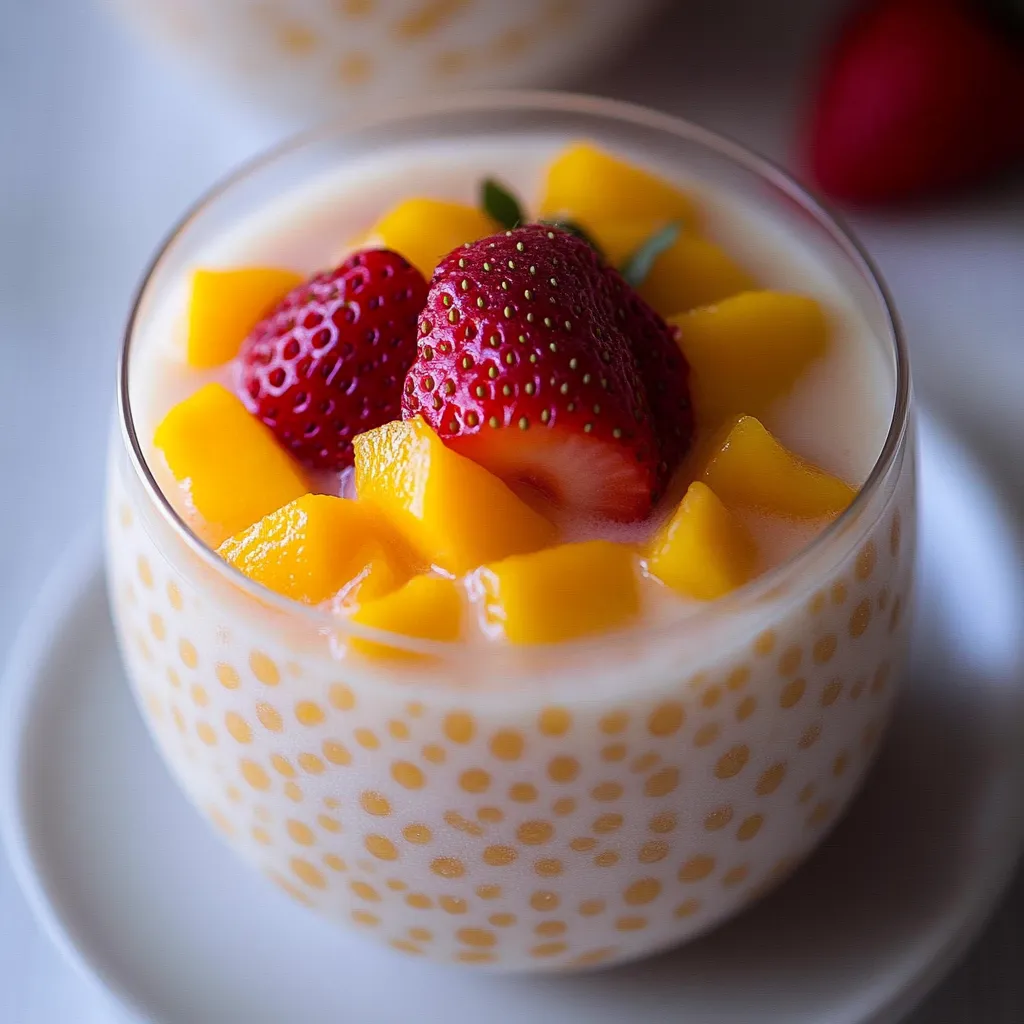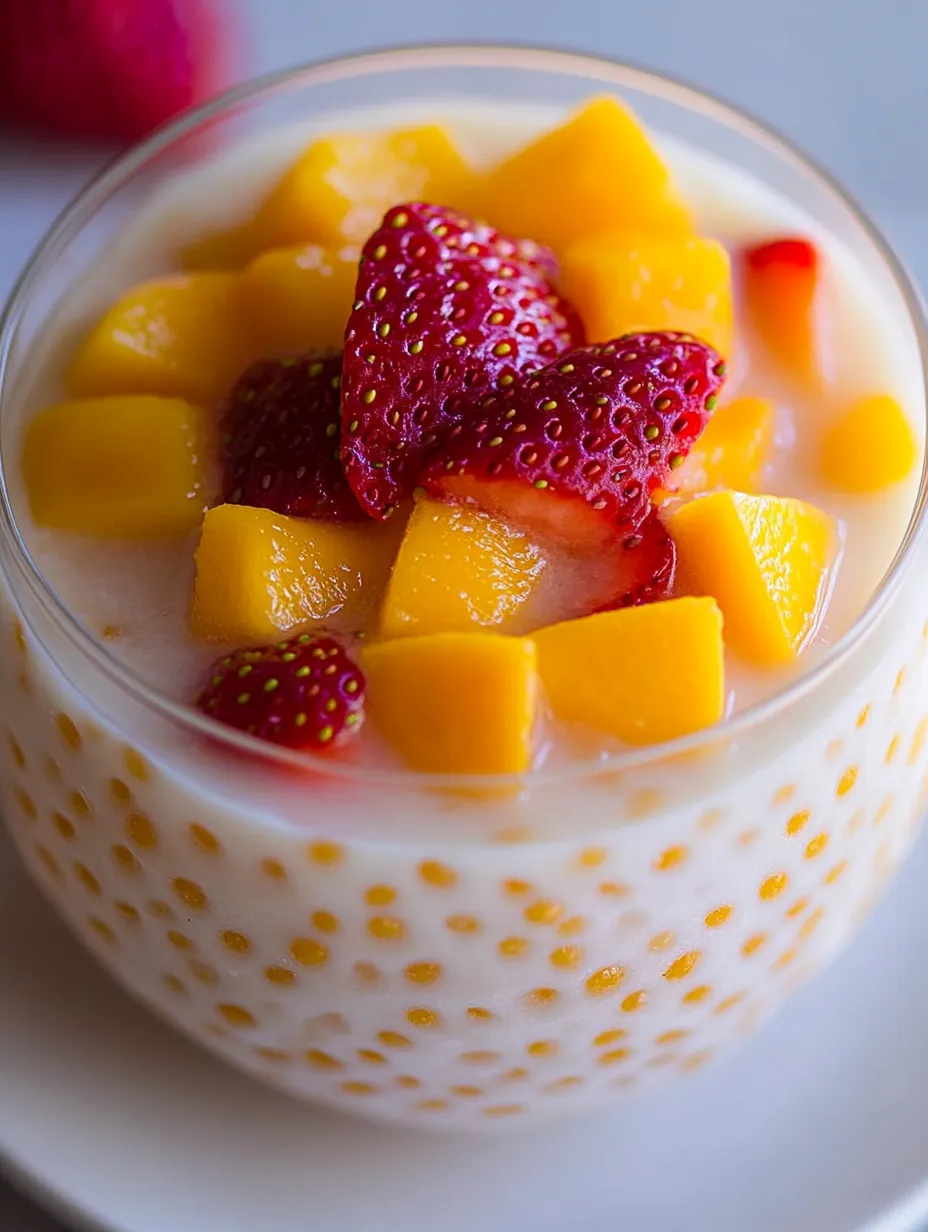 Save
Save
This refreshing strawberry coconut sago combines the sweet juiciness of fresh fruits with chewy tapioca pearls, all swimming in a creamy coconut milk base. It's a perfect balance of textures and flavors that works beautifully as a light dessert or afternoon treat during warm weather.
I first made this during a particularly hot summer weekend when my family was craving something cool and refreshing but not too heavy. The empty glasses and requests for seconds told me this would become part of our regular dessert rotation.
Ingredients
- Fresh ripe mangoes Their natural sweetness and tropical flavor are essential to this dish. Look for mangoes that yield slightly to gentle pressure.
- Fresh strawberries They add a beautiful color contrast and a slight tartness that balances the sweetness. Choose bright red berries without white shoulders for best flavor.
- Sago pearls or tapioca pearls These tiny balls transform during cooking to provide the signature chewy texture. Find them in Asian grocery stores or online.
- Coconut milk Creates the creamy base for this dessert. Use full fat for the richest flavor and texture.
- Condensed milk Adds sweetness and richness. The recipe works with regular or coconut condensed milk for a vegan option.
Step-by-Step Instructions
- Cook the Sago Pearls
- Bring 3 cups of water to a rolling boil in a medium pot. Add the sago pearls and cook for about 10 minutes, stirring occasionally to prevent clumping and sticking to the bottom. You'll know they're done when most of the pearls become translucent with just a tiny white dot in the center. Remove from heat, cover with a lid, and let them sit for an additional 10 minutes to finish cooking through.
- Rinse the Pearls
- Drain the cooked pearls through a fine mesh strainer and rinse under cold running water. This stops the cooking process and removes excess starch that can make the dessert gummy. Gently swirl the pearls while rinsing until the water runs clear.
- Combine All Elements
- In a large mixing bowl, combine the rinsed sago pearls, coconut milk, condensed milk, most of the mango cubes and most of the strawberry slices. Make sure to reserve some fruit for garnishing. Stir gently but thoroughly to distribute everything evenly.
- Chill the Dessert
- Cover the bowl and refrigerate for at least 30 minutes or until thoroughly chilled. The flavors will meld together and the dessert will thicken slightly as it cools.
- Serve and Garnish
- Spoon the chilled dessert into individual glasses or bowls. Top each serving with the reserved mango and strawberry pieces for a beautiful presentation. Serve immediately while still cold.
 Save
Save
The key to this dessert is getting the sago pearls just right. The first time I made this, I undercooked them slightly and they were too firm in the center. Now I always perform the taste test after they've rested off heat to ensure they have that perfect chewy but tender texture throughout.
Storage Tips
This strawberry coconut sago will keep well in the refrigerator for up to 3 days when stored in an airtight container. The sago pearls may absorb more of the liquid over time, so you might want to add a splash more coconut milk before serving if it's been refrigerated for more than a day. The fruit will gradually release juices into the mixture, which actually enhances the flavor, though the texture of the fruit pieces will soften.
Fruit Variations
While mango and strawberry create a stunning color contrast and flavor combination, this recipe works beautifully with many other fruits. Try using ripe peaches or nectarines in late summer, or berries like blueberries and raspberries. For a tropical twist, add some diced pineapple or passion fruit pulp. The key is to use fruits that are at their peak ripeness for maximum flavor and natural sweetness.
Serving Suggestions
For an elegant presentation, serve this dessert in clear glasses to showcase the beautiful layers of white pearls and colorful fruits. To make it more substantial, you can add a scoop of vanilla ice cream or a dollop of whipped coconut cream on top. It also pairs wonderfully with crisp cookies like thin almond biscotti or coconut tuiles for textural contrast.
Cultural Background
This dessert draws inspiration from various Asian culinary traditions, particularly Thai, Filipino, and Chinese cuisines where coconut milk, fresh tropical fruits, and chewy elements like tapioca pearls are commonly combined in desserts. Similar desserts include Filipino halo halo, Thai ruam mit, and Chinese mango pomelo sago. Each culture puts their own spin on these refreshing sweet treats that are particularly popular during hot weather.
 Save
Save
Recipe FAQs
- → Can I use frozen fruit instead of fresh for this dessert?
Yes, frozen mango and strawberries can work well in this dessert. Thaw them completely and drain any excess liquid before adding to your sago mixture. Fresh fruit provides the best texture and flavor, but frozen is a convenient alternative when fresh isn't available.
- → What's the difference between sago pearls and tapioca pearls?
Sago pearls are made from starch extracted from the pith of sago palm stems, while tapioca pearls come from cassava root starch. They're similar in appearance and texture, though sago tends to be more translucent when cooked. Either can be used in this dessert with comparable results.
- → How long can I store leftovers in the refrigerator?
This dessert can be stored in an airtight container in the refrigerator for up to 2-3 days. The sago pearls may absorb more liquid during storage, so you might need to add a splash of coconut milk before serving leftovers.
- → Can I make this dessert vegan?
Absolutely! Simply substitute regular condensed milk with coconut condensed milk as mentioned in the ingredients list. All other components are naturally plant-based, making this an easy dessert to adapt for vegan diets.
- → What other fruits work well in this dessert?
This versatile dessert works beautifully with many tropical and soft fruits. Try passion fruit, lychee, papaya, peach, or banana as alternatives or additions to the mango and strawberry. The key is using fruits that complement the creamy coconut base.
- → Why did my sago pearls turn mushy?
Overcooking is the most common cause of mushy sago pearls. For the perfect chewy texture, cook them just until translucent with a tiny opaque center, then allow them to finish cooking off-heat. Rinsing with cold water immediately after cooking also helps maintain their pleasant bouncy texture.
